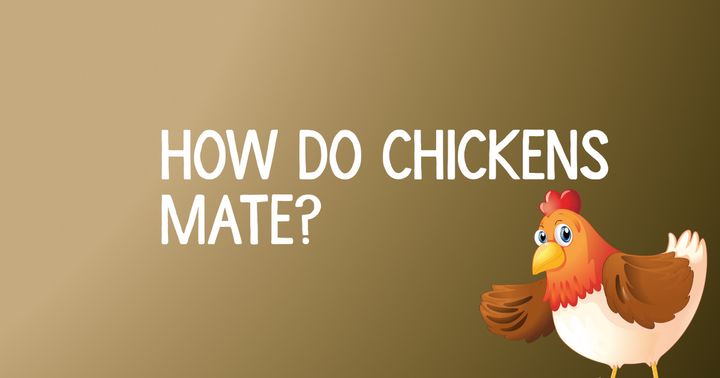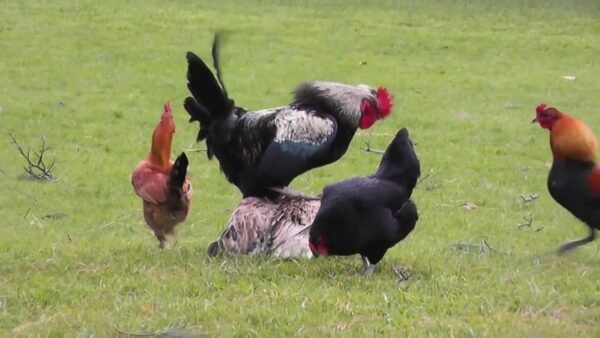How Do Chickens Mate


How do chickens mate?
It's a question that's puzzled philosophers and school children for thousands of years.
It hasn't puzzled poultry farmers, of course. They're sensible people -- they have ready access to chickens, and they just watch.
The thing about chickens is -- the answer to how they mate might not be as simple as you'd naturally think it is.
First of all, roosters are mate-ready all year round, but the mating instinct intensifies in the spring.

There are some odd and unusual parallels between chicken mating and human mating. How far the parallels go will largely depend on your own experience.
If they go all the way, you just might want to see other people. And probably, when all is said and done, fewer chickens.
When the rooster's feeling particularly mate-ready, he will begin paying hens more particular and ardent attention, initiating courtship behavior patterns all by himself.
In particular, he's likely to begin displaying 'tid-bitting' behaviors.
Yes, that's exactly what it sounds like. He will begin earmarking gifts for the hen or hens of his choice. Mostly, these will consist of choice food gifts, as a way of announcing his particular existence, and his potential as a food-provider.
This is absolutely not known as the "Dinner At Mario's" phase of chicken mating -- but it probably could be. The "order whatever you like, I love to see you eat" is more or less implied by the gift of food itself.
Arguably like males everywhere, when he presents the gift of food, the rooster won't simply leave it and go. He will call his chosen hen over, point out the gift, bob his head, peck at the food and cluck like a mother hen.
In human terms, this would be the "Sure, baby, whatever you like. You have the lobster, I'm good for it" phase.
In the event of the mate-wild rooster living in a particularly rooster-rich environment, the second necessary display phase will be initiated. Our invested rooster will try and chase any others who may show interest away.
There may be even be chest-bumping and hardcore cock-fighting (we're sorry, that was inevitable!) and in a sense, our rooster invests his whole chance of mating with the hen at this point. The rooster that loses the challenge will usually retire and forfeit his interests in mating...at least for the moment.
This would be the "I'll keep you safe from all those other losers, baby, you stick with me, I'm your man" phase of chicken mating.
So much for the preliminaries of courtship in roosters. When we see him again, things are going to get serious.
But there's a certain 'takes two to tango' element in chicken mating.
While it's true that in many breeds of particularly tasty hen, we as humans have bred this instinct out of them, in many other breeds, hens still feel the call of spring too.
While Rooster-Boy has been tid-bitting his self-invested beak off, the hen or hens in his circle of awesome cockiness will have been getting broody, building nests, getting the hormonal vibe of mating in their bodies and behaviors.
Research from the University of British Columbia and the University of Minnesota (Cheng and Burns, 1998: Dominance Relationship and Mating Behavior of Domestic Cocks -- A Model To Study Mate-Guarding And Sperm Competition In Birds) has indicated that hens are not quite the helpless recipients of male attention the rooster-action may have made it seem.
They're keeping a beady eye out for the best looking roosters in their vicinity. They're looking for a vibrant comb, shiny feathers, impressive wattles.
We'd love to think of this as the "Sex And The Chicky" phase of chicken mating, but there is of course more to it than that. The shiny feathers and vibrant comb aren't purely aesthetic elements in chicken mating.
They're evolutionary indicators of health, of good nutrition, or of the likelihood of creating a healthy next generation of chicks. It's not so much the "Sex And The Chicky" phase of mating as the "23AndMe Meets Ancestry.com" phase. Whatever Captain Tid-Bit thinks and tries, if he's not also Captain Perfect-Genes, there's a strong chance some of those eggs he crows about won't be his.
Also, there are reasons why Captain Tid-Bit does what he does. Hens are judging not only the looks of the roosters in their region -- they're judging precisely the things the rooster's display are intended to convey. The ability to provide food. The ability to protect them and their chicks from other potentially predatory males.
Hens, incidentally, are perfectly happy to accept tid-bits from any and all roosters who want to give them to them. They're not about to blithely exchange food treats for mating rights though. And importantly, while Captain Tid-Bid may declare himself the Alpha Male in the area and see off challenges from other roosters, hens won't necessarily mate with him simply by virtue of his Alpha-ness.
If you like, you can think of this as the "We Never Said We Were Exclusive" phase.
OK. So much for all the mood-setting. The occasional glance across the farmyard, the surreptitious wattle-gazing, the "Call me" clucks to the handsome beta roosters. The tid-bitting and cock-fighting and nest-building. It's all been building if not the sexual tension, then certainly the mating mood. But now...it's all or nothing.
The hens have been looking for protective providers with a shiny feather-suit. The rooster has been doing his best to fit their criteria, providing food-treats, fighting off other roosters, trying to establish himself as an eligible mating-partner.
For the "Barry White" phase of the mating process, the rooster doesn't get a gold medallion on and start crooning in a voice like liquid satin. But he does do the thing that many males throughout the animal kingdom do. If hens are looking for a bright comb and shiny feathers, then a bright comb and shiny feathers they will get.
He begins what has been described as the "foreplay" of the chicken world by a kind of dance. Yes, the Chicken Dance. Good luck not thinking of that the next time you hear the song.
The actual Chicken Dance involves dropping a wing into the dust, exposing the bright, shiny feathers normally hidden from view. Once the wing is dropped, Barry -- yes, the rooster's named Barry now -- will drag the wing around the hen, giving her an indication of what's on what's left of his mind.
We've said hens can be pleasingly independent when it comes to mating. They're not necessarily going to look at Droopwing Barry and just go with it because he wants it. But they have a poultry version of consent. If the hen's not interested, there will be feathers flying.
If Barry's done his job right and the seduction is on like Chicken Kong, the hen will almost bow to signal her willingness. She will squat or crouch (again, it's probably worth re-examining the actions that go with the Chicken Dance music... Just saying). She will drop her head and body lower, and spread her wings to show her interest.
When the wings are spread, the rooster knows what it means. Having dragged his wing around the hen, when he gets behind her, things...get...crazy.
In the "Banzai!" phase of chicken mating, the rooster takes a leap, high onto the hen.
We're talking "step up and down among her feathers to get purchase" leaping, even in some cases grabbing hold of some head feathers -- because nothing breaks the mood like a tumbling cock.
When the fix is secure, it's time for the hardcore poultry porn.
There's no real easy way to tell you this.
Gentlemen, it's time to stand a little taller. The rooster, longstanding avatar for priapic masculinity...has no penis.
It's a game-changer, isn't it, that knowledge?
What he has instead is a tiny bump inside his cloaca, called the papilla. The papilla is akin to the rooster's otherwise non-existent testicle.
The cloaca? That's what you could honestly call the business end. The oh-so-much-business end. In chickens, it's a common chamber and a single outlet. The intestinal, the urinary, and the genital tracts open into the cloaca, and from there, it's an express train out of the chicken.
Lots of business happens in the cloaca.
Now, before the gentlemen start to smirk, your common-or-farmyard rooster can mate between 10-30 times a day. And in the morning, when his sperm-load is higher, he can deliver between 10 million and 5...billion sperm. Per mating. Not too shabby for a bird with no penis.
So how does insemination and fertilization happen?
Basically, the secret to the survival of chicken in the world is butt-kissing.
When the rooster's safely perched on top of the hen, he will lower his tail, exposing his cloaca.
She will raise her own cloaca to meet him, and in what is regularly described as a 'cloacal kiss', their cloacas touch and boom! Anything up to 5 billion sperm, no waiting, transferred from him to her.
Job done.
And once the job is done, the rooster usually gets off immediately and leaves the hen alone, in what could well be called the "Of course I'll call you, babe" phase of chicken mating. The hen, meanwhile, frequently shakes out her feathers and takes care of herself in the wake of the gigantic sperm-dump. You should feel free to name that phase of chicken mating for yourself.
It's worth remembering that on average, hens produce an average of one egg per day. It's also worth considering that inside the hen, sperm will be retained in 'sperm pockets' in the hen's oviduct. Rooster sperm can remain viable in the hen's body to fertilize oncoming eggs for up to four or five days.
So during peak mating season, that can be a lot of chicken mating -- per chicken, per day -- to transfer a truly staggering amount of sperm from the rooster into the hen, to fertilize the next generation of eggs into chicks.
And while both hens and roosters may be hot and hormonal during mating season, once the hen begins to sit on the eggs to incubate and hatch them, she has no interest in the rooster's potentially ongoing attempts to empty his papilla. In fact, she will more often than not chase him right away from her, in what, in a perhaps unnecessary burst of cynicism, we're calling the "I can't believe I let you do this to me again" phase of chicken mating.
And so the circle -- or at least the oval -- of life continues. Whether you have a one-rooster-to-many-hens or a several-roosters-to-many-hens set-up, or whether the chickens are doing their chicken thing entirely outside of human observation and help, it's worth remembering that as we speak, there are over 23.7 billion chickens in the world, compared to just slightly under 8 billion humans. Chickens have several similarities to humans in their mating behaviors. The tid---bitting, the display, the protective and possessive urges, the search for strong genetics to produce the most healthy offspring.
One thing though remains clear from the numbers. With a daily egg to fertilize and a truly intimidating number of sperm to be delivered in every mating, whatever else can be said about chicken mating, from an evolutionary perspective, they're doing it really well.

